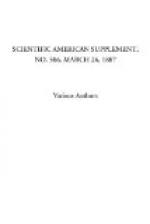The former has boats under construction 148 ft. long, 15 ft. beam, to make 420 revolutions with 130 lb. of steam, the guaranteed speed being 23 knots on a continuous run of two hours’ duration, with a load of 15 tons. They will have triple-expansion or compound direct-acting surface-condensing engines and twin screws, Thornycroft’s patent tubular boilers, double rudders, electric search lights, three masts and sails.
While the armaments of the various boats differ, Thornycroft is prepared to fit the launching tubes with either air or powder impulse, to mount the tubes forward or on deck, and also the fittings for machine and rapid firing guns.
Yarrow and Co. have contracted for boats varying in length from 117 ft. to 166 ft., with fittings and armament as may be required. They have obtained excellent results in their last English boat of the Admiralty type. They are, in fact, prepared to guarantee a speed of 23 knots in a length of 125 ft. and 25 knots in a length of 140 ft., carrying in both causes a mean load corresponding to fuel and armament of 10 tons.
And so the progress goes on, but it will not stop here; it has already incited a marked development in ship construction, and the endeavors to withstand torpedo attack have improved the defense against gun fire also.
In quoting a German opinion on the development of the Russian torpedo fleet, Charmes refers to the type which will, no doubt, be most successful upon the sea, namely, the torpedo cruisers, and it is to this type, more than for any other, that we may expect torpedo boats to be adapted. Already, writers have dropped the phrase “torpedo boats” for “torpedo vessels.”—Engineering.
* * * * *
FIRING TRIAL OF THE 1101/2 TON B.L. ELSWICK GUN.
The firing trial of the first new 1101/2 ton breech loading gun approved for H.M.’s ships Benbow, Renown, and Sanspareil was commenced recently at the Woolwich proof butts, under the direction of Colonel Maitland, the superintendent of the Royal Gun Factories. We give herewith a section showing the construction of this gun (vide Fig. 8). It very nearly corresponds to the section given of it when designed in 1884, in a paper read by Colonel Maitland at the United Service Institution, of which we gave a long account in the Engineer of June 27, 1884.
The following figures are authoritative: Length over all, 524 in.; length of bore, 487.5 in. (30 calibers). The breech engages in the breech piece, leaving the A tube with its full strength for tangential strain (vide Fig.). The A tube is in a single piece instead of two lengths, as in the case of the Italia guns. It is supplied to Elswick from Whitworth’s works, one of the few in England where such a tube could be made. There are four layers of metal hoops over the breech. Copper and bronze are used to give longitudinal strength. The obturation is a modification of the De Bange system, proposed by Vavasseur.




